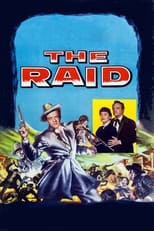John Chard
Feb 20, 2017
9/10
With a rebel yell, I cried more more more.
"This is a true story...it began on the night of September 26 1864, in a Union prison stockade at Plattsburgh, New York, not many miles from the Canadian border."
Tho director Hugo Fregonese's The Raid opens with the above written statement, it's not entirely accurate. Further research into what became known as "The St. Albans Raid" is required if you want the complete and unembellished story. However, The Raid is in structure and plot significantly in line with what happened back there in 1864. Lifting from the story entitled "Affair At St. Albans" by Herbert Ravenal Sass, The Raid is about seven Confederate prison escapees who infiltrate the community of St. Albans and plot a second front. As the town is gleefully praising General Sherman's march towards Savannah - and throwing auctions to sell off mementos of slain "Rebel" soldiers, the "Rebs" are fashioning bottles of "Greek Fire" with which to torch the town as they plunder the bank of all the town money.
Naturally all doesn't go to plan, as an on the edge soldier puts a spanner in the works; and the "Reb" leader, Maj. Neal Benton (aka Neal Swayze), finds a conflict of interest as his relationship with Katie Bishop and her son starts to form. All of which helps to make The Raid an engrossing picture outside of its already high interest point for being a "Confederate" movie (how many can you name about the "Rebs" winning for example?). More so when one knows that the film doesn't revert to genre formula, it threatens to, but Fregonese and his crew are not interested in serving up standard fare, with the ending a particular point of reference to ram home that opinion.
Van Heflin is excellent as Benton/Swayze, put this along side his work in other Western outings like Shane and 3:10 To Yuma, and he surely is a candidate for the genre's most undervalued actor award. Watch as he has to suppress various forms of emotion - anger as the town around him rejoices in his fellow countrymen's misfortune - affection as he gets close to the mother and son, and torn as he ultimately must abide by his war driven codes. A fine turn from a very fine actor. Anne Bancroft is suitably bright eyed and deep down strong as Katie, while Richard Boone does a nice line as the troubled, and limb absent Captain in desperate need of redemption. Lee Marvin, Claude Akins (uncredited) and Peter Graves man up the support cast, and a nod of approval is warranted for young Tommy Rettig as Larry Bishop.
Filmed on location at Iverson Ranch, Chatsworth, Los Angeles, California, I find myself once again searching for superlatives about Lucien Ballard's cinematography. This is a "gorgeous" film to look at, the Technicolor crisp in tone as the brown and orange hues of St. Albans play host to the shimmering blues of the soldiers uniforms, all of course about to be engulfed by the crackling spurts of the raiders incendiary use of "Greek Fire". I fell in love with this movie quite early on in proceedings, come the finale, I knew I just had to have it in my own collection, I can only hope that this picture finds a new audience from which to give it the love it dearly deserves. 9/10
